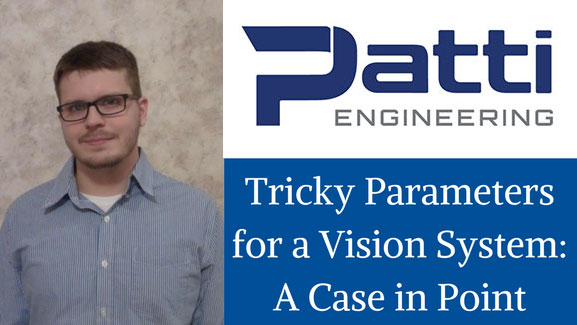
Tricky Parameters for a Vision System: A Case in Point
by Dan Bock, Controls Engineer
Vision systems are tricky; they need to be reliable and accurate in any possible scenario. Even in a favorable environment for a vision system, without proper testing, it is possible for the vision system to work under most circumstances, but completely fail under niche conditions. It’s the system integrators job to always thoroughly test anything they work on to provide the customer with best, most reliable system possible.
On a previous Patti Engineering project, we created a vision program that accurately measured up to fifteen different dimensions on a single part. For this specific application, we used two Cognex Displacement Sensors, model number DS1101, and the corresponding software, Cognex Designer. After deciding on the hardware that would give the results we needed in an acceptable time, we started developing a system we could use to reliably test the accuracy and efficiency of the vision program.
Cognex Designer Software allows the programmer to record images and store them into an image database. Using Cognex Image Viewer software we were able to edit image databases to create standard test image sets. These image sets would contain best-case scenarios, worst-case scenarios, images of parts with known bad dimensions, and multiple images of the same part.
Next, we created a test mode in our Cognex Designer vision program to run these image databases instead of live parts. We also used Cognex Designer’s built-in SQL functionality to record each measurement. After processing all the images in a database, we would export all the recorded data to a .csv file. Finally, we made Excel spreadsheets to that would let us compare different data sets, highlight problem values, and automatically generate statistics for that run.
Using these image sets Patti Engineers were able to rapidly test and validate changes to the vision program. We determined the best way to remove noise from the image using filters, the best tools to get accurate measurements, and create the image masks to get an accurate pattern recognition in a reasonable time. Without these tools, we would not have been able to create as good of a system as we did.
One way to determine if a vision system would work well for your line is to conduct an engineering feasibility study. An engineering feasibility study gathers and analyzes enough information about the system, the required parameters, and the conditions to determine if the next stage is feasible. We sometimes recommend engineering feasibility studies for complex projects. They can save significant cost and headaches for the customer if it is determined that the project is not feasible. Better to determine that upfront than well into the project!
Related categories: Blog Control Systems Integration

